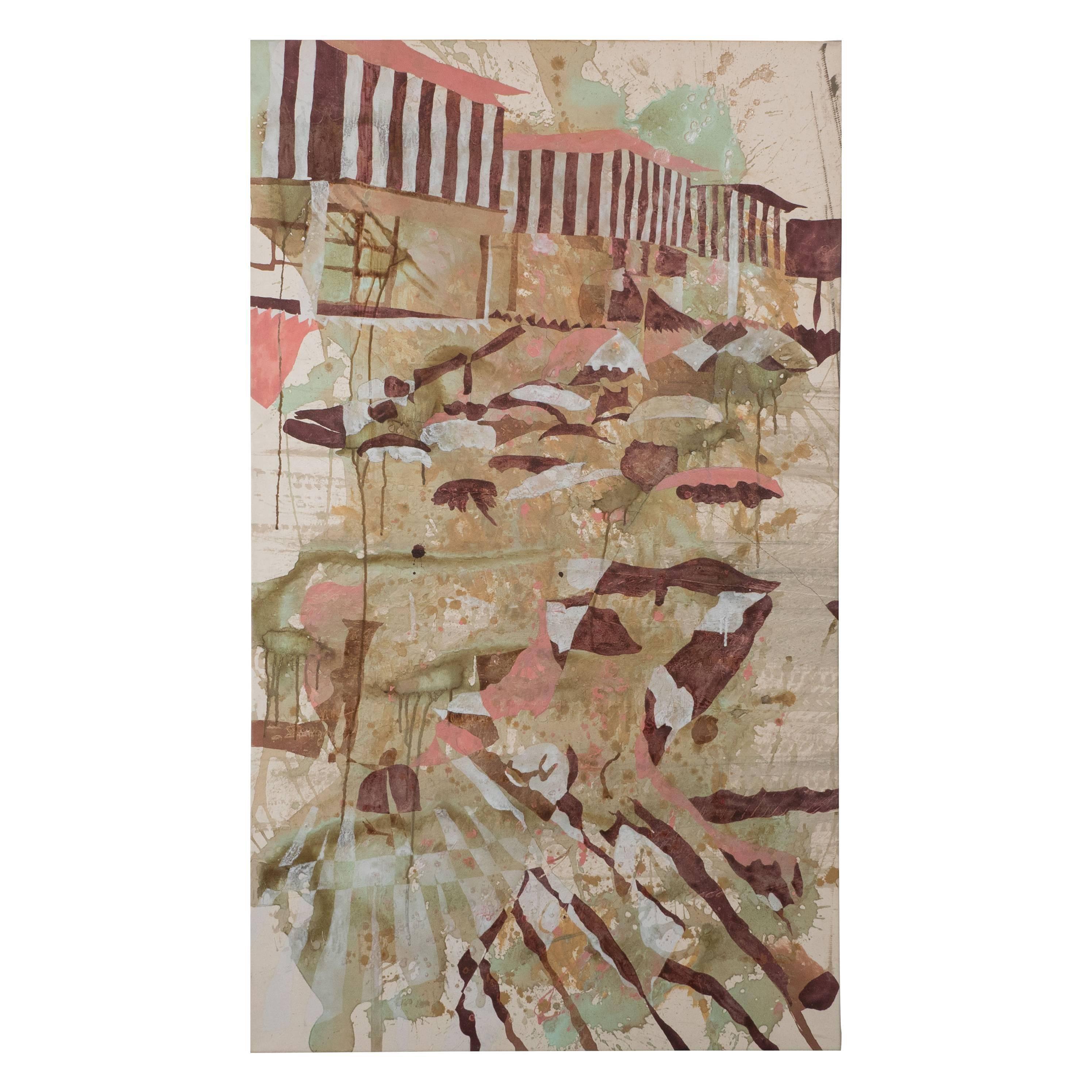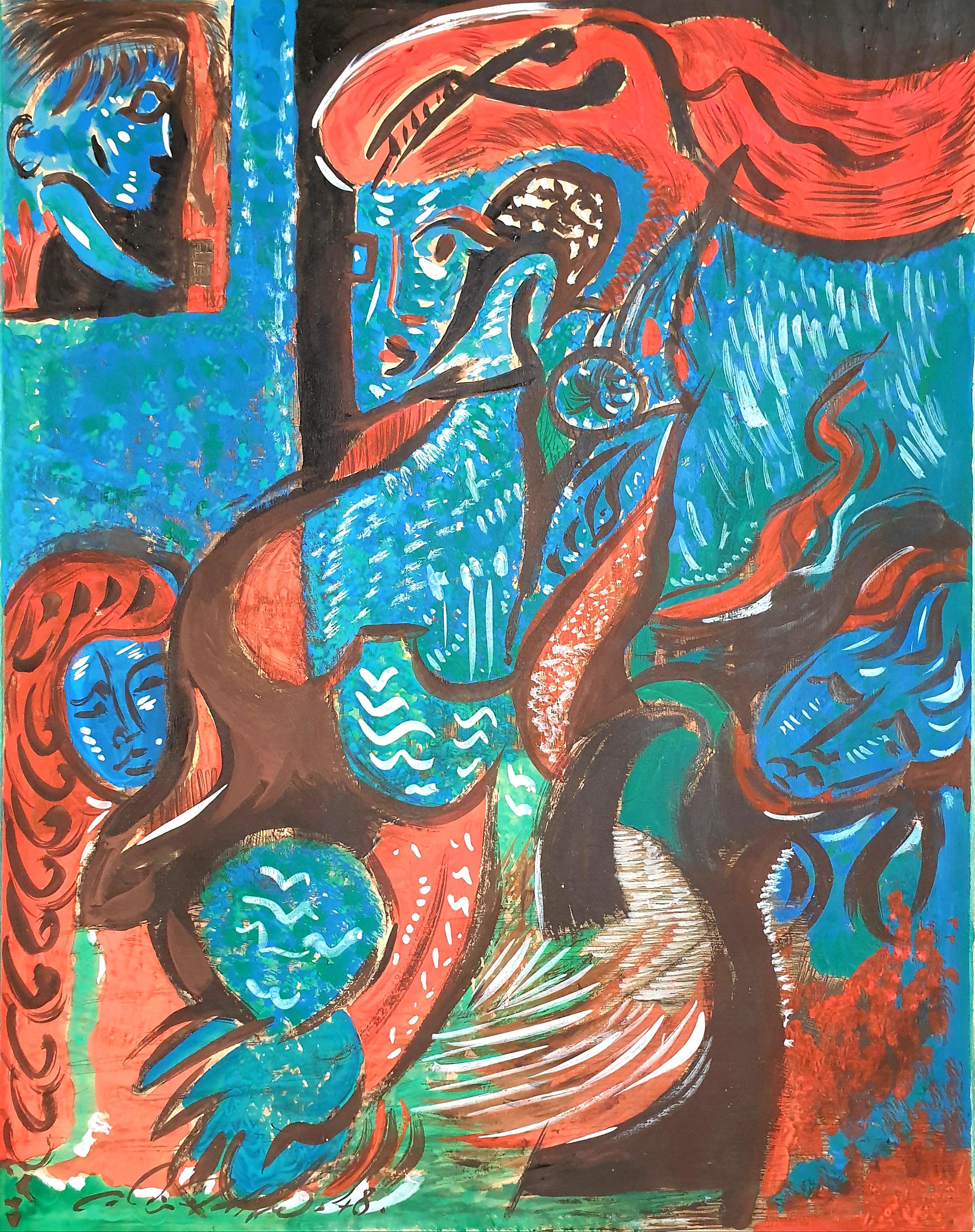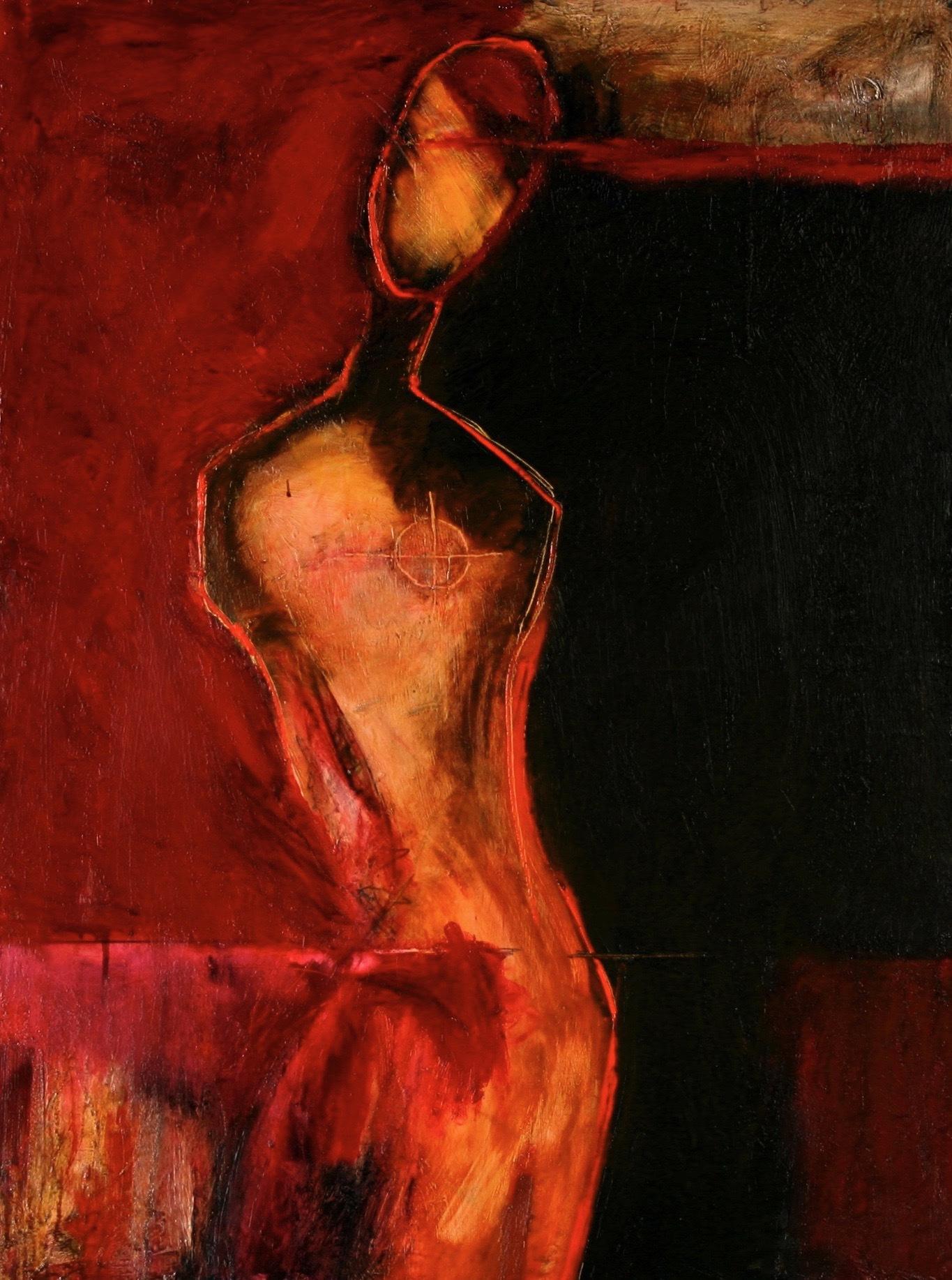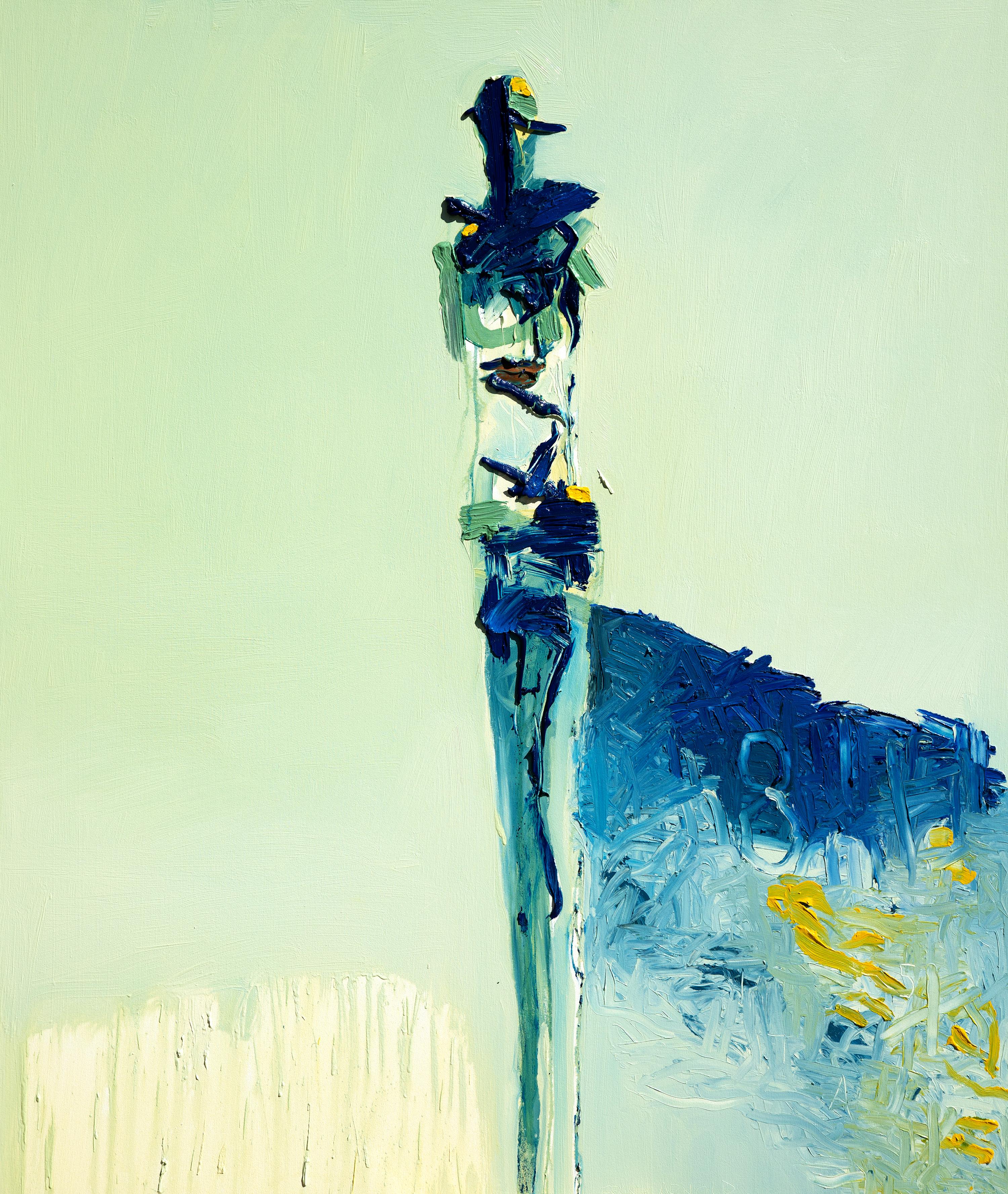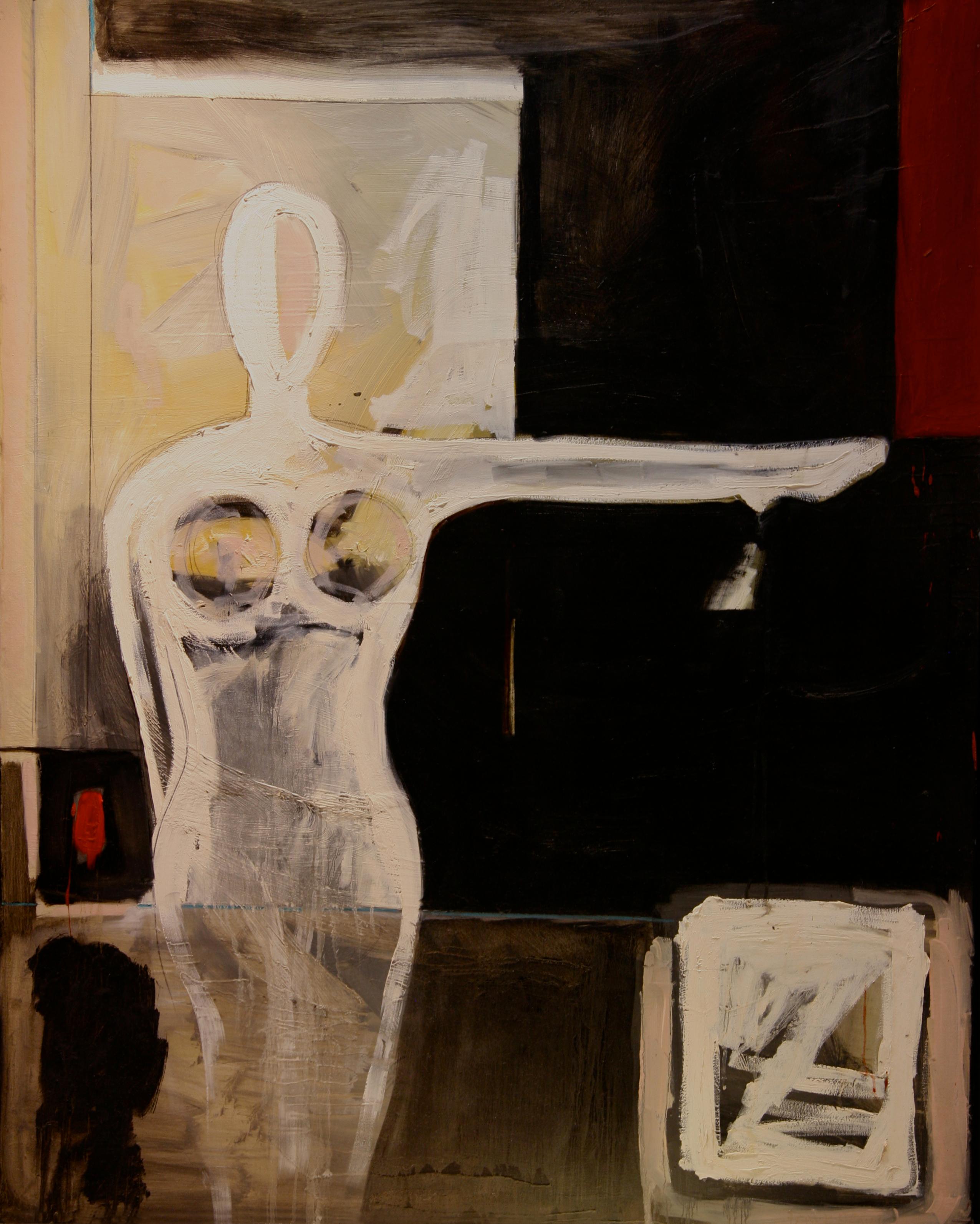Items Similar to Spanish Catalan Modernist Oil Painting Drummer Boy Figurative Abstraction
Want more images or videos?
Request additional images or videos from the seller
1 of 9
Artur DuchSpanish Catalan Modernist Oil Painting Drummer Boy Figurative Abstraction1984
1984
About the Item
Artur Duch Puig, born 1951 in Sitges
In 1971 he started studying at the St. Jordi School of Fine Arts in Barcelona.
There he developed his artistic skills in the fields of sculpture, painting and engraving. People and circus, symphonic orchestras and musicians, where plasticity takes vitality and colors come into play. Artur Duch exhibition in Sitges. Do it in the area of Nicolás Art Gallery of Àngel Vidal. Sitges has coalesced perennially into a constellation of artists that goes back to the days of Bernat de Fonollar with Ferrer Bassa as the founding genius of a group of artists, painters and sculptors who have lived and worked in the Blanca Subur.
Artur Duch exhibited in the Miramar building in Sitges with a retrospective entitled Impermanencia, the eternal change of all things, organized by the Department of Culture with Mireia Pascual at the head of the proposal commissioned by Beli Artigas Coll. That was a recognition to a "legal" artist, who from his Sitges studio in Poble Sec has overcome the cyclical crises of the artistic, galeristic or commercial sector, which is increasingly weakened. For more than 40 years Artur Duch 's work has left his studio before the Hospital of San Juan Bautista to the art galleries of Lleida, Tarragona, Girona, Barcelona, Huesca, Malaga, Madrid, Cuenca, Palma Mallorca, León, Burgos, Santander, Valencia, Castellón, Brighton and Brussels .
In Sitges Duch, he began public exhibitions at Galeria Nueva , a small place on Carrer Nou that Pierre Txetverikoff kept open, combining the sale of antiques with the exhibitions of the works of young promises such as Artur himself, in Lligades Pujadas , in Xisco Mensua , in Jordi Roses or Diego Guirao , next to those of the most renowned and renowned artists such as Daza Rosas (Almeria, 1934 - Sitges, 1992), Bruno (Sitges, 1921 - 2000), Juan Navarro Ramón (Altea, Alicante , 1903 - Sitges, 1989) and Anna Lenchs ( Montzen , Belgium 1943). One of his teachers was Ramon Sanvisens , a professor at the Sant Jordi School of Fine Arts in Barcelona, where in 1971 Artur Duch entered, being a faithful master's disciple until he realized that once you know how to fly (paint) you have to discover New horizons, new ways for oneself, growing in change, finding and opening new paths unpublished. Artur Duch now exhibits his most intimate and last pictorial production. Plastic, material and gestural work; abstract, yes, abstract and abstract from the figurative context where it had been left. Accompany the new stage with iron sculptures that shelter stones: nests pedrals. Beyond the subject and the way we can discover the emotion. Stop striving untiringly for a prescribed sense, better take advantage of the intuition, the mildest of sensations, it can lead us to a knowledge of the whole that no word can express. Beyond the words, silence opens the door to deep contemplation, to a thorough look that identifies us with a state of consciousness where sensory perception extends to become transcendent. The most subtle vibration, the milder volume, the finer texture, the more intense color, the gestures captured in the matrical paste, Duch overflows its visual world and moves towards new perceptions where emotion and color They give the spirit and new impulse to fly high, feeling the air, water, stone, earth, wood, everything and nothing. Matter and gesture, color and aura.
There have been many exhibitions of his works in Spain (Madrid, Barcelona, Valencia, Santander, Osca, Lleó, Málaga) as well as Europe (France, Britain,Holland,Switzerland, Andorra), as well as in Mexico and the United States
- Creator:Artur Duch (1951, Spanish)
- Creation Year:1984
- Dimensions:Height: 21.75 in (55.25 cm)Width: 18.5 in (46.99 cm)
- Medium:
- Movement & Style:
- Period:
- Condition:unstretched. minor wear.
- Gallery Location:Surfside, FL
- Reference Number:1stDibs: LU38213353632
About the Seller
4.9
Platinum Seller
These expertly vetted sellers are 1stDibs' most experienced sellers and are rated highest by our customers.
Established in 1995
1stDibs seller since 2014
1,550 sales on 1stDibs
Typical response time: 1 hour
- ShippingRetrieving quote...Ships From: Surfside, FL
- Return PolicyA return for this item may be initiated within 3 days of delivery.
More From This SellerView All
- Large Pop Art Oil Painting "Pear" Modernist Colorful Composition Suzanne MearsLocated in Surfside, FLBold, colorful, still life oil painting of a pear. In lush, vibrant color. SUZANNE WALLACE MEARS During college she focused on painting and clay. Then it became photography and clay, then only clay, then kiln formed glass and today its kiln formed glass, painting and plasma cut steel sculpture. She also works in oil paint and encaustic. Reminiscent of the color works of Jim DIne and the fruit paintings of Tom Seghi. She never works with only one medium. She uses color and texture to create energetic, luminous, joyous works with the glass. Bright, bold color using reds, blues, oranges reflect my travels in color saturated countries such as Tibet, Nepal, China and Mexico. At random I use solid color fields as a challenge to my driving love of vibrant color. Her favorite themes are inspired by nature and antiquity. Kiln formed glass uses flat sheets of glass which are cut into shapes, layered and incorporate accessory elements of frits, copper wire and mesh, pieces of sheet copper or brass and dichroic glass fired in a kiln. EDUCATION BA, University of Iowa, Iowa City, Iowa, 1964 Graduate School, 44 hours, double major Summer School University of Wisconsin, Madison, Wisconsin 1963 Master Class, Patty Gray Instructor, tde Glass Furnace, Turkey Master Class, Richard La Londe...Category
20th Century Pop Art Abstract Paintings
MaterialsCanvas, Oil
- French Jewish Post Holocaust Abstract Painting Manner of Hundertwasser Art BrutBy Jichak PressburgerLocated in Surfside, FLJichak Pressburger, Painter. b. 1933, Bratislava, Czechoslovakia. A concentration camp survivior. Came to Israel aboard the ship, "The Exodus". 1964 Went to Paris. In 1979 Returned as new immigrant. Education Tel Aviv University, B.A. in art, with Marcel Janco and Isidor Ascheim at Avni art school. Beaux Arts, Paris with Professor Coutaud. Itzchak Pressburger Stays in Paris from 1963 – 1979, Resident of the “Cité des Arts” 1969-1972. Lives and works in Jerusalem since 1979. One-Man Exhibitions 1963 Gallery Dugit, Tel-Aviv 1968 Cultural Center Enkhuizen, Netherlands 1968 Gallery Zunini, Paris (chosen by the art critic of « Opus : Jean-Jacques Lévèque) 1970 Gallery Zunini, Paris 1973 Gallery Maitre Albert, Paris. Cultural Center Verfeil sur Seye, France 1974 Gallery Maitre Albert, Paris 1976 Gallery Mundo, Barcelone 1980 Artists’ House, Jerusalem 1981 Gallery Alain Gerard, Paris Group Exhibitions 1966 Rathaus Charlottenburg, Berlin. (The first show of Israeli painters in Germany Artists Center of Silvarouvres, Nantes, Ffance XXXth Salon of Finances at “l’Hotel des Monnaies”, Paris 1969 Maison de Culture, Le Havre, France 1968 Gallery Zunini, Paris (chosen by the art critic of « Opus : Jean-Jacques Lévèque) Salon « Grands et Jeunes d’Aujourd’hui », Paris Museum of Fine Arts, Nantes, France Cultural Center Vitry, France Gallery Il Giorno, Milan Cité des Arts, Paris 1972 Salon “Grands et Jeunes d’Aujourd’hui”, Paris Salon de Mai, Paris 1973 Städtische Galerie, Siegen, Germany 1974 Jewish Cultural Center, Paris Publicis, Paris 1975 Réalitiés Nouvelles, Paris 1976 Salon de Mai, Paris 1977 “Perspectives Israeliennes”, Grand Palais, Paris 1981 Salon Alain Gerard, Paris 1984 Artists’ House, Jerusalem Publication 1990 Haggadah Yom Kippour (Hebrew/French) Abraham Bliah (private edition), Paris Acquisitions 1968 The City of Paris 1972 The State of France The Yitzchak Pressburger artist was born in Bratislava – known for centuries by its German name of Pressburg – but the outbreak of World War II found him and his family in Prague. His father realized they had to escape from the Nazi occupiers and tried to get the family across the border into Hungary. However, they were caught near the crossing point, arrested and incarcerated overnight at the nearby railway station. The Czechs put them on a train to Hungary early the next morning. That was their first miracle in their quest for survival. They survived with relative ease until late 1943, when the father was taken away to a forced labor camp. He subsequently died in a death march. Things became even more precarious in early 1944, when the Holocaust made its full-blown presence felt in Hungary. “It wasn’t the Germans, it was the Hungarian Nazis who did the dirty work,” Pressburger points out. The family lived in so-called “safe houses” that were protected by Switzerland, Finland and Sweden. The havens were dismantled in late 1944, and the Pressburgers moved into one of the two Jewish ghettos in Budapest. The Nazis had found two houses with Jews, including the one where we had been, and took them all out and shot them next to the Danube. Today there is a monument by the river [called Shoes on the Danube Bank]. We should have been with the Jews who were killed by the river,” he says. After the war, Pressburger and his siblings were farmed out to various orphanages run by the Jewish Agency, and things took a decidedly better turn. “We finally had food to eat,” he recalls. “After a while we were put on trains that were protected by the Jewish Brigade [of the British Army], and we were sent to Austria, and then to Germany.” “My uncle was a famous artist, and I learned a lot from him,” he says. While in Germany, Pressburger also took some lessons with a local artist. His mother managed to get him and two of his siblings berths on the Exodus, which set sail from Marseilles for Palestine in July 1947. Pressburger was 13 at the time and clearly recalls the aborted attempt to get to the Promised Land. “It was so crowded on the boat. This was a ship that was made to ply rivers in the United States, with a few hundred people on board, and we had over 4,500 passengers crammed in.” As we know, the British prevented the Exodus from docking in Palestine, and the passengers were shipped – in three far more seaworthy vessels – back to France. After the French government refused to cooperate with the British, Pressburger and the others found themselves back in Germany. The teenager eventually made it here in 1948, just one month before the Declaration of Independence. After a short furlough in Tel Aviv, during the first lull in the fighting in the War of Independence, he moved to Kibbutz Kfar Ruppin, where he worked in the cowshed. All the while he continued feverishly drawing and honing his artistic skills, which he says came in handy when he joined the IDF. After completing his military service, which included a spell as one of the founding members of the Flotilla 13 naval commando unit, he worked in Sdom for a while at the Dead Sea Works before starting his formal arts training in earnest. I was in the first group of students at the Avni Institute [in Tel Aviv],” he says. “There was quite a famous bunch of students and teachers like Moshe Mokadi and Isidore Ascheim and Aaron Giladi.” In such illustrious company, one might have thought Pressburger was set to unleash his burgeoning talents on art connoisseurs across the globe, but it was a while before that happened. Pressburger arrived in the French capital in 1964 and spent close to 15 years there, with a short interlude in Germany, before returning to Israel. His time in Paris was a professionally rewarding period of his life, and he also found love. “[Avni Institute teacher] Yochanan Simon gave me the name and address of a French-Israeli family in Paris, but when I got to the house, a young woman opened the door and told me the family was on vacation in Israel,” he explains. Despite missing his expected hosts’ welcome, he and the German-born young lady who greeted him soon fell for each other, and romance quickly led to wedding bells. By all accounts, Pressburger did well in Europe. He secured a rare three-year berth at Cité Internationale des Arts, where artists are normally provided with accommodation and studio space for between two months and a year. He was also accepted to the prestigious Beaux Arts academy of fine arts, mounted solo exhibitions, and took part in group shows all over Europe. One of these last was a group exhibition at Rathaus Charlottenburg in Berlin in 1966 – the first exhibition of Israeli artists in Germany after the Holocaust. When he arrived in Berlin, the lineup for the Israeli show was already signed and sealed, but somehow his work came to the attention of the German culture minister, who arranged for him to join. The Pressburgers’ year-long sojourn came to an abrupt end following an encounter he had one day while walking through the crowded Berlin streets...Category
1960s Expressionist Abstract Paintings
MaterialsCanvas, Oil
- Israeli Cubist Modernist Oil Painting "Rosh Shiryon Abir" ArmorBy Shlomo ZafrirLocated in Surfside, FLShlomo Zafrir is active/lives in Israel, France. Shlomo Zafrir is known for cubist painting. Shlomo Zafrir is a painter and, at the same time, the owner of a nightclub called Omar K...Category
1960s Cubist Abstract Paintings
MaterialsCanvas, Oil
- Abstract Procession Jewish Wedding Chuppah Oil Painting Modernist JudaicaBy Sabina TeichmanLocated in Surfside, FLGenre: Modern Subject: Abstract Medium: Oil Surface: Canvas Country: United States Sabina Teichman: (1905-1983) Studied at Columbia Univ. (BA, MA), also with Charles J. Martin and A...Category
1950s American Modern Figurative Paintings
MaterialsCanvas, Oil
- Judaica Modernist Oil Painting 'Know Thyself' Israeli Kibbutz Pioneer, ProphetBy Mortimer BorneLocated in Surfside, FLMortimer Borne, Printmaker, painter, sculptor, and educator was born in Rypin, Poland in 1902 and emigrated to the US in 1916. He studied at the National Academy of Design, The Art Students League, The Beaux-Arts Institute of Design, and with Charles Webster Hawthorne, founder of the Cape Cod School of Art in Provincetown. Painted in a thick impasto style similar in technique to Samuel Rothbort and David Burliuk. Borne himself taught at The New School for Social Research in New York City from 1945-1967. From the 1920s through the 40s he was a prolific producer of New York City cityscapes and genre scenes. In later decades, he adopted a more modernist style apparently influenced by Picasso, producing color drypoints of abstracted figures. His works were widely exhibited in museums in the U.S. and abroad from 1931 and later, including the Art Institute of Chicago, the American Institute of Graphic Arts, Museum of Modern Art, Metropolitan Museum of Art, Corcoran Gallery of Art, New York Public Library, Carnegie Institute, and Royal Society of Painters, Etchers and Engravers in London. He taught at The New School for Social Research in New York City from 1945-1967, and at the Tappan Zee...Category
1970s Modern Figurative Paintings
MaterialsCanvas, Oil
- Israeli KIbbutz Artist Toddler, Swim Tube Pointilist Oil Painting Bezalel SchoolBy Arie KaplunLocated in Surfside, FLBelarusian born Israeli artist. lived in germany studied at the Bezalel School. Bezalel Academy of Arts and Design is Israel's national school of art. Established in 1906 by Jewish...Category
20th Century Pointillist Figurative Paintings
MaterialsCanvas, Oil
You May Also Like
- Contemporary Painting "Contagian" by Molly Dilworth, Acrylic on Canvas, 2009By Molly DilworthLocated in New York, NYMolly Dilworth "Contagian". Acrylic on canvas created in 2009. Measures: 35.5" W X 60.25" H. Signed on revers "Molly Dilworth/2009". This striking painting depicts what first appe...Category
Early 2000s Post-Modern Abstract Paintings
MaterialsCanvas, Acrylic
- 'Motherhood' A Redhead Beauty with Children. Mid-century Oil on Paper.Located in Cotignac, FRMid-century post modern oil on paper of a woman with children. Signed and dated 1948 to the bottom left, (the artist as yet undiscovered). An arrestin...Category
Mid-20th Century Post-Modern Figurative Paintings
MaterialsPaper, Oil
- Last DanceBy Frank ArnoldLocated in Fresno, CALast Dance is an Oil on Canvas painting in soft, light aqua tones with red/brown accents. Frank Arnold is thought by many to be one of the foremost abstract...Category
2010s Abstract Abstract Paintings
MaterialsCanvas, Oil
- My Other SideBy Frank ArnoldLocated in Fresno, CA“My Other Side” is 48”x 36”. This is an earlier piece by Arnold from the estate of a late collector of his work. This piece is predominantly shades of red from light to almost black....Category
Early 2000s Abstract Abstract Paintings
MaterialsCanvas, Oil
- New MoveBy Frank ArnoldLocated in Fresno, CA"New Move 8" Oil on Canvas is a mix of blues and greens with chrome yellow accents. Frank Arnold is thought by many to be one of the foremost abstract figurative painters and sculpto...Category
2010s Abstract Abstract Paintings
MaterialsCanvas, Oil
- Oil on Canvas “Blake’s Wish”By Frank ArnoldLocated in Fresno, CA"Blake’s Wish" is 60” x 48”. Solo female figure Dominant colors are black, white and deep crimson red.. Frank Arnold’s paintings exhibit the highest quality materials for a truly arc...Category
2010s Abstract Abstract Paintings
MaterialsCanvas, Oil
